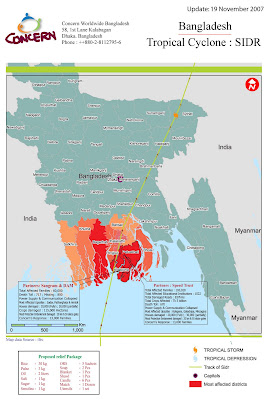19th November 2007· Disaster management control room reported 2,300 people dead in 23 districts due to the Cyclone Sidr which hit Bangladesh on 15th November. It is also reported from different sources that over 4,000 people are seriously injured. The Bangladesh Red Crescent has expressed fears that the death toll will cross 10,000
· Thousands are still missing and it is unofficially forecasted that the dead and missing will be over 5,000.
· It is estimated that the cyclone has affected 887,000 families of 103 upazilas, killed 242,000 livestock and destroyed crops on 23,000 acres of land and flattened nearly three million houses.
· Road communication with southern districts was disrupted due to fallen tress and debris caused by the cyclone. Many of the affected areas are inaccessible and can be reached only by helicopter.
· The whole country suffered electricity shortage and subsequent shortage in water supplies in the major cities from night of 15th. Dhaka city returned to normalcy after 36 hours. Countrywide, there are still problems in electricity supply.
· There are extreme shortages in food supplies and shelter in the affected areas.
Narrative
Country Level Update
Cyclone Sidr on the 15th November caused nightmare in Bangladesh. Ripping through the south western coast killing thousands of people, demolishing houses, crops, livestock left a trail of devastation over thousands of square kilometres. The winds reached 240km per hour hitting the coast at 7.30 pm on 15th November and cutting off all communications and utility services across the country.
Despite evacuation of hundreds of people, the country still suffered a high number of deaths. As of 18th November, the disaster management control room reported death of 2,300 people in 23 districts due to the Cyclone Sidr. It is also reported from different sources that nearly 4,000 people are seriously injured. Thousands are still missing and it is unofficially forecasted that the dead and missing will be over 5,000. It is estimated that the cyclone has affected 887,000 families of 103 upazilas, killed 242,000 livestock and destroyed crops on 23,000 acres of land and flattened nearly three million houses.
According to an official of the Agriculture Extension department crop loss will be more than Tk 49.7 billion. Tidal waves 6-7 feet high engulfed the coastal areas washing away everything in their path. The actual destruction in the Sundarbans (the world’s largest mangrove forest and home to the Royal Bengal Tiger) cannot be ascertained. Aerial footage by the national TV channels have shown dead wildlife amongst broken vegetation and forestation. There are extreme shortages in water and food supplies and shelter in the affected areas.
Dead bodies are being collected and in many areas mass burials have had to be carried out without proper religious rites. Road communication with southern districts was disrupted due to fallen trees and debris caused by the cyclone. Many of the affected areas are inaccessible and can be reached only by helicopter. This is hampering relief and rescue operations. Steps are being taken by the government and army to restore road network and power supply across the country to normalcy as soon possible.
The whole country suffered electricity shortage and subsequent shortage in water supplies in the major cities from night of 15th. Dhaka city returned to normalcy after 36 hours. Countrywide, there are still problems in electricity supply.
Emergency Interventions
The government has sanctioned Tk 35 crore for housing in the cyclone hit areas, priority is being given to Patuakhali, Bagerhat, Pirojpur, Barisal, Barguna, Jhalakati, Bhola, Madaripur, Gopalganj, Shariatpur, Khulna and Satkhira. Currently 732 medical teams are working in these areas. Rescue operations are being carried out by the army, air force and navy. Dry food is being provided, however, many areas are still hard to reach and these people are facing acute crisis of food and fresh drinking water.
The government welcomes assistance form the international community. The donors have pledged $25 million in aid. After two floods this year, Bangladesh economy will be hard hit. The international community, i.e. the UN, EU, Germany, USA, UK and others have expressed that they will make funds available to respond to Bangladesh’s disaster.
WFP has sent dry food to the affected areas and the Red Crescent has 42,000volunteers working in these areas. Red Crescent will be providing non-food materials such as clothes, water-purifying tablets and medicine to the coastal districts. National NGOs like BRAC have mobilised its funds for the response and deployed 2,500 staff round the clock to help in the worst affected coastal districts. Similarly many INGOs and donors are making assessments and preparations to respond as soon as possible.
Concern Worldwide Response Concern Worldwide, Bangladesh continuously monitored the situation and deployed Concern staff and partner organisation staff to assess the extent of the disaster and identify the areas and communities which need help acutely, keeping in mind the need to avoid duplication with relief operations by other NGOs.
Concern Worldwide, Bangladesh continuously monitored the situation and deployed Concern staff and partner organisation staff to assess the extent of the disaster and identify the areas and communities which need help acutely, keeping in mind the need to avoid duplication with relief operations by other NGOs.
Concern has been in communication with EC and is forming a proposal to assist 26,000 extremely poor families in Patuakhali and Barguna. It has been estimated that over 250 thousand families have been affected, death toll so far 1487 in these two districts. The relief package being proposed includes both food and non-food material (see details in Map). Concern is receiving funds of Euro 580,000 from EC and Euro100,000 from Concern General Donations. The relief operations have started today in the target areas.
Monday, November 19, 2007
Bangladesh Cyclone SIDR Update
Posted by
Concern Worldwide Bangladesh
at
11:18 AM
![]()
Subscribe to:
Post Comments (Atom)

No comments:
Post a Comment